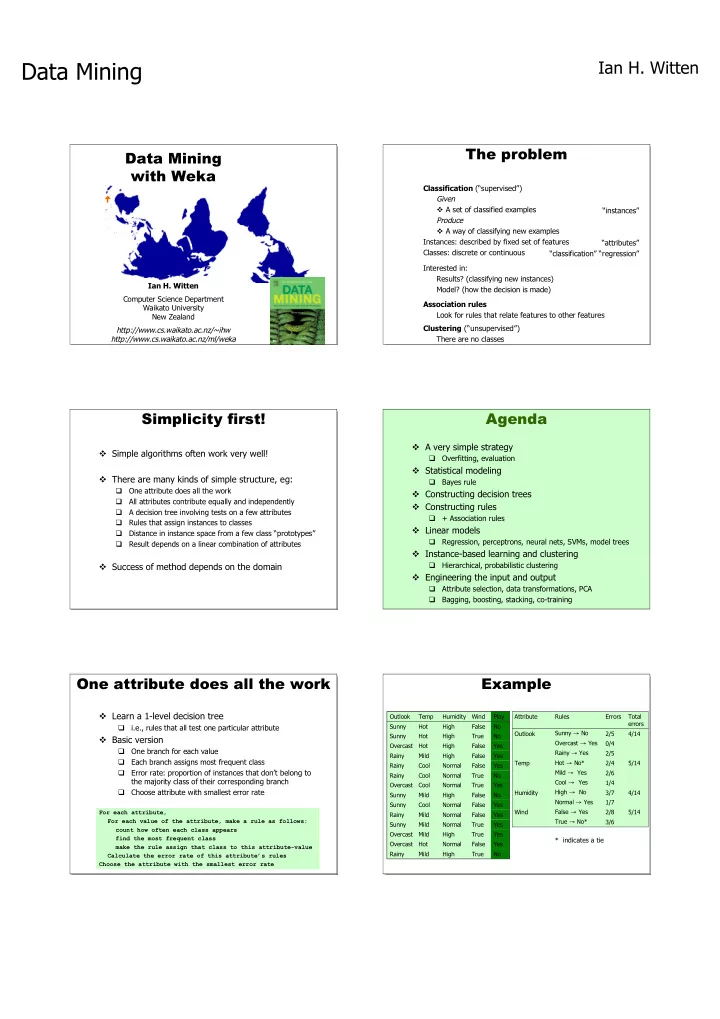

Data Mining Ian H. Witten The problem Data Mining with Weka Classification (“supervised”) Given A set of classified examples “instances” Produce A way of classifying new examples Instances: described by fixed set of features “attributes” Classes: discrete or continuous “classification” “regression” Interested in: Results? (classifying new instances) Ian H. Witten Model? (how the decision is made) Computer Science Department Association rules Waikato University Look for rules that relate features to other features New Zealand Clustering (“unsupervised”) http://www.cs.waikato.ac.nz/~ihw http://www.cs.waikato.ac.nz/ml/weka There are no classes Simplicity first! Agenda A very simple strategy Simple algorithms often work very well! Overfitting, evaluation Statistical modeling There are many kinds of simple structure, eg: Bayes rule One attribute does all the work Constructing decision trees All attributes contribute equally and independently Constructing rules A decision tree involving tests on a few attributes + Association rules Rules that assign instances to classes Linear models Distance in instance space from a few class “prototypes” Regression, perceptrons, neural nets, SVMs, model trees Result depends on a linear combination of attributes Instance-based learning and clustering Success of method depends on the domain Hierarchical, probabilistic clustering Engineering the input and output Attribute selection, data transformations, PCA Bagging, boosting, stacking, co-training One attribute does all the work Example Learn a 1-level decision tree Outlook Outlook Temp Temp Humidity Humidity Wind Wind Play Play Attribute Rules Errors Total errors i.e., rules that all test one particular attribute Sunny Sunny Hot Hot High High False False No No Sunny → No Outlook 2/5 4/14 Sunny Sunny Hot Hot High High True True No No Basic version Overcast → Yes 0/4 Overcast Overcast Hot Hot High High False False Yes Yes One branch for each value Rainy → Yes 2/5 Rainy Rainy Mild Mild High High False False Yes Yes Each branch assigns most frequent class Temp Hot → No* 2/4 5/14 Rainy Rainy Cool Cool Normal Normal False False Yes Yes Error rate: proportion of instances that don’t belong to Mild → Yes 2/6 Rainy Rainy Cool Cool Normal Normal True True No No the majority class of their corresponding branch Cool → Yes 1/4 Overcast Overcast Cool Cool Normal Normal True True Yes Yes Choose attribute with smallest error rate Humidity High → No 3/7 4/14 Sunny Sunny Mild Mild High High False False No No Normal → Yes 1/7 Sunny Sunny Cool Cool Normal Normal False False Yes Yes Wind False → Yes 2/8 5/14 For each attribute, Rainy Rainy Mild Mild Normal Normal False False Yes Yes For each value of the attribute, make a rule as follows: True → No* 3/6 Sunny Sunny Mild Mild Normal Normal True True Yes Yes count how often each class appears Overcast Overcast Mild Mild High High True True Yes Yes find the most frequent class * indicates a tie Overcast Overcast Hot Hot Normal Normal False False Yes Yes make the rule assign that class to this attribute-value Rainy Rainy Mild Mild High High True True No No Calculate the error rate of this attribute’s rules Choose the attribute with the smallest error rate
Data Mining Ian H. Witten Complications: Missing values Complications: Overfitting Nominal vs numeric values for attributes Omit instances where the attribute value is missing Outlook Temp Humidity Wind Play Attribute Rules Errors Total Treat “missing” as a separate possible value errors Sunny 85 85 False No Temp 85 → No 0/1 0/14 Sunny 80 90 True No 80 → No 0/1 “Missing” means what? Overcast 83 86 False Yes 83 → Yes 0/1 Rainy 75 80 False Yes Unknown? 75 → Yes 0/1 … … … … … Unrecorded? … … Irrelevant? Memorization vs generalization Do not evaluate rules on the training data Is there significance in the fact that a value is missing? Here, independent test data shows poor performance To fix, use Training data — to form rules Validation data — to decide on best rule Test data — to determine system performance Evaluating the result One attribute does all the work Evaluate on training set? — NO! This incredibly simple method was described in a 1993 paper Independent test set An experimental evaluation on 16 datasets Used cross-validation so that results were Cross-validation representative of performance on new data Simple rules often outperformed far more Stratified cross-validation complex methods Stratified 10-fold cross-validation, Simplicity first pays off! repeated 10 times Leave-one-out The “Bootstrap” “Very Simple Classification Rules Perform Well on Most Commonly Used Datasets” Robert C. Holte, Computer Science Department, University of Ottawa Agenda Statistical modeling One attribute does all the work? A very simple strategy Overfitting, evaluation Opposite strategy: use all the attributes Statistical modeling Two assumptions: Attributes are Bayes rule equally important a priori Constructing decision trees statistically independent (given the class value) Constructing rules I.e., knowing the value of one attribute says nothing + Association rules about the value of another (if the class is known) Linear models Independence assumption is never correct! Regression, perceptrons, neural nets, SVMs, model trees But … often works well in practice Instance-based learning and clustering Hierarchical, probabilistic clustering Engineering the input and output Attribute selection, data transformations, PCA Bagging, boosting, stacking, co-training
Recommend
More recommend